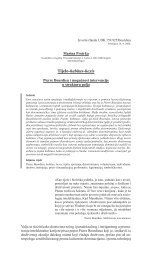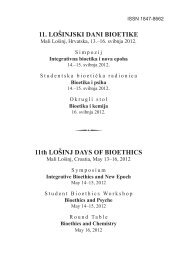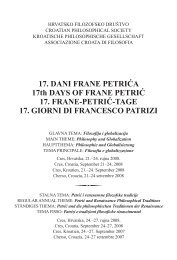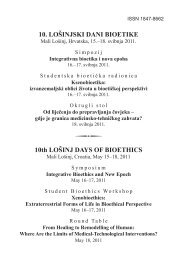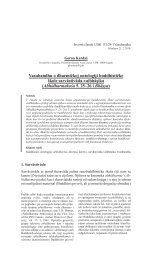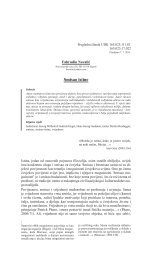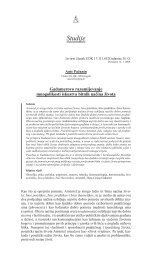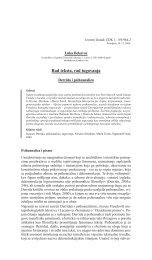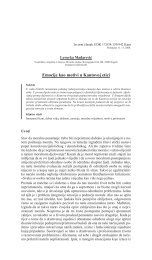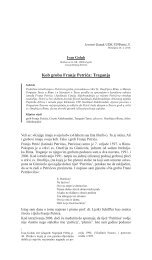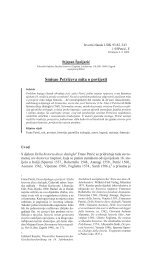Programska knjižica - Hrvatsko filozofsko društvo
Programska knjižica - Hrvatsko filozofsko društvo
Programska knjižica - Hrvatsko filozofsko društvo
You also want an ePaper? Increase the reach of your titles
YUMPU automatically turns print PDFs into web optimized ePapers that Google loves.
VLADIS VUJNOVIĆ 1 , INGA LISAC 1 , IVICA MARTINOVIĆ 2<br />
1<br />
Geophysical Department, Faculty of Natural Sciences and Mathematics, University<br />
of Zagreb, Croatia /<br />
Geofizički odsjek, Prirodoslovno-matematički fakultet, Sveučilište u Zagrebu,<br />
Hrvatska<br />
2<br />
Institute of Philosophy, Zagreb, Croatia /<br />
Institut za filozofiju, Zagreb, Hrvatska<br />
HISTORICAL AND SCIENTIFIC COMMENTARY<br />
OF BOŠKOVIĆ’S DISSERTATION DE AURORA BOREALI (1738)<br />
Between his studies of philosophy and theology, Ruđer Bošković worked<br />
for six years as a magister in the lower classes of the two Jesuit colleges: in<br />
Rome and in Fermo, but in addition to his regular teaching duties, from 1736<br />
he embarked upon the research and publishing of the treatises in mathematics,<br />
astronomy and meteorology. The fruit of such scientific interest is the treatise<br />
De aurora boreali, which Bošković submitted to the academic public on two<br />
occasions, first in August 1738 at the Roman Seminary (in Seminario Romano),<br />
and at the Roman College (in Collegio Romano) the following month, shortly<br />
before he began his studies of theology. Based on Martinović’s translation of<br />
the treatise De aurora boreali into Croatian, it is interpreted and commented<br />
from the perspective of the history of science (Martinović) and from the standpoint<br />
of the physics of the atmosphere (Vujnović and Lisac).<br />
In constructing the treatise, young Bošković followed the scientific style<br />
of his professor of mathematics Orazio Borgondio, who at the Collegium Romanum<br />
published treatises with the same text organisation from 1713 to 1734:<br />
division into propositions and corollaries. By that time Bošković zealously<br />
read Newton’s Opticks, the latter’s first Latin edition from 1706, for in the<br />
treatise he cited Query 20, where Newton concludes that “the density of air<br />
is proportional to the force compressing it”. He rightly leaned on Mairan’s famous<br />
treatise Traité physique et historique de l’Aurore Boréale, first published<br />
in 1731 in the Mémoires de l’Académie Royale des Sciences in Paris, and two<br />
years later in a separate book. Bošković used the method that Mairan applied<br />
for the calculation of the aurora height which appeared on 19 October 1726,<br />
and borrowed also two of his drawings, adapting them to his conclusions and<br />
calculations. For the appearance of aurora borealis on 16 December 1737, he<br />
drew on the report Observatio Aurorae Borealis, visae nocte insequenti diem<br />
XVI. Decembris, Anno 1737 by Giovanni Poleni, professor of mathematics at<br />
the University of Padua, published in Venice in 1738 together with four other<br />
183



